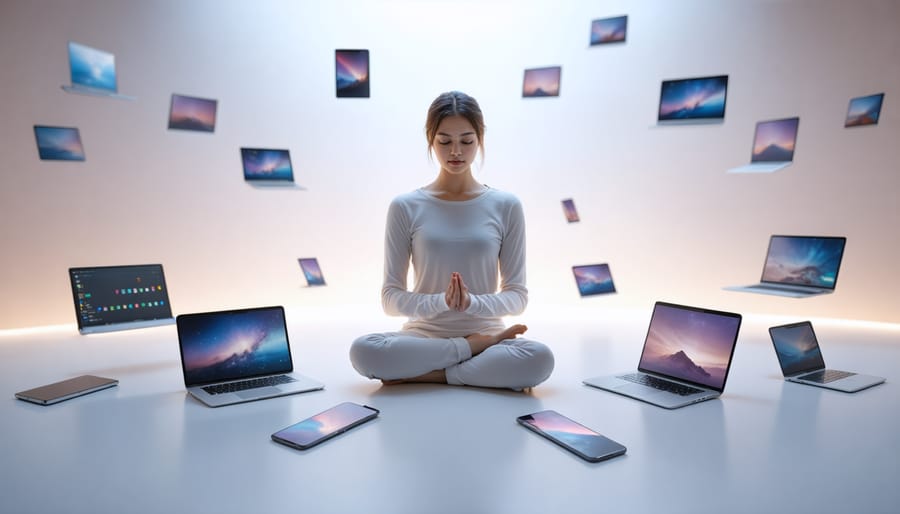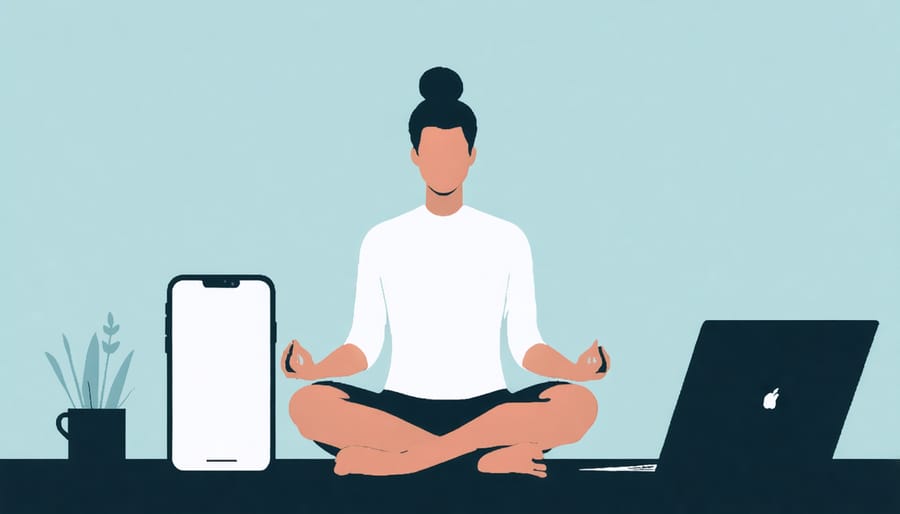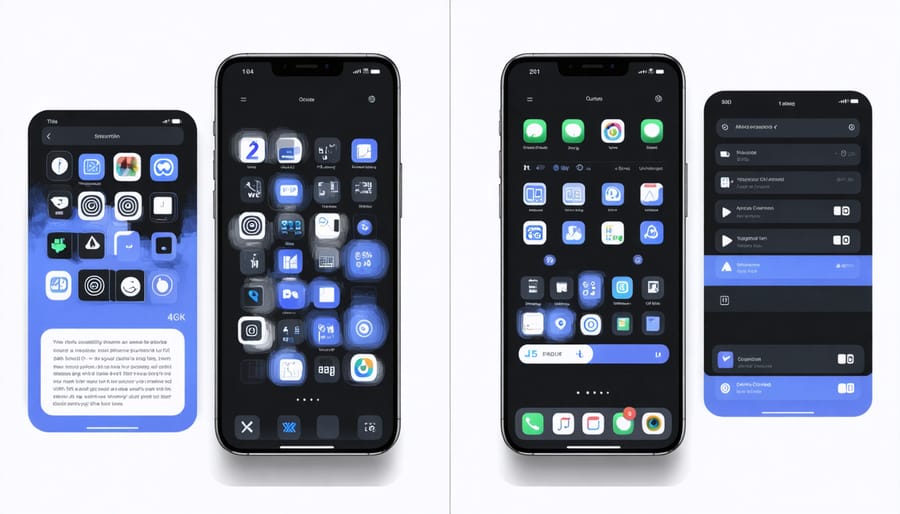
In a world where our phones buzz constantly and screens demand our attention, finding digital peace feels like searching for silence in a storm. Yet the intersection of technology and mindfulness isn’t about choosing between our devices and our well-being – it’s about creating harmony between them. As a recovering phone-checker who once spent countless hours mindlessly scrolling, I’ve discovered that technology itself isn’t the enemy of present-moment awareness. Instead, it can become a powerful ally in our journey toward mindfulness.
Picture your smartphone not as a distraction machine, but as a potential gateway to calm. Whether it’s through meditation apps that guide our breathing, screen time monitors that keep us accountable, or simple reminder notifications to pause and check in with ourselves, the very tools that often pull us away from the present moment can actually help anchor us within it. The key lies not in rejecting our digital world, but in learning to navigate it with intention and awareness.
Let’s explore how to transform our relationship with technology from one of mindless consumption to mindful connection.
When Technology Becomes Too Much

The Hidden Stress of Always Being Connected
You know that flutter in your stomach when you hear another notification ping? That’s your body’s subtle way of telling you something’s up. Like many of my readers, I used to pride myself on being “always available,” responding to messages within minutes. But this constant connection comes with a hidden cost that goes beyond the obvious distractions.
Think about how often you check your phone during dinner with friends or peek at work emails while watching your favorite show. These micro-interruptions create a state of continuous partial attention, where we’re never fully present in any moment. Our brains remain in a low-level state of alertness, almost like leaving dozens of browser tabs open in our minds.
The most challenging part? This digital stress has become so normalized that we often don’t recognize it anymore. It’s like background noise we’ve learned to tune out, yet it continues to affect our mood, sleep, and relationships.
Your Body’s Response to Screen Time
Our bodies weren’t designed for endless hours of screen time, and they’re definitely letting us know. Have you noticed that tight neck after a long day at work, or those tired eyes that just won’t stop burning? These aren’t just minor inconveniences – they’re your body’s way of raising a red flag. The blue light from our devices disrupts our natural sleep patterns, while poor posture from constant device use can lead to chronic pain. To balance your body and mind, it’s essential to recognize these physical signals. Digital eye strain can cause headaches and blurred vision, while prolonged sitting with devices affects our circulation and energy levels. The good news? Being aware of these responses helps us make conscious choices about our tech use. Simple adjustments like maintaining proper posture, taking regular movement breaks, and using blue light filters can make a significant difference in how our bodies respond to screen time.
Creating Your Digital Sanctuary

Mindful Moments in Your Digital Day
In our always-connected world, finding moments of mindfulness doesn’t mean completely disconnecting. Instead, it’s about creating intentional pauses and bringing awareness to our digital interactions. Let’s explore some simple mindful practices you can easily weave into your tech-filled day.
Start by taking three deep breaths before checking your phone in the morning. This small ritual helps set a conscious tone for the day ahead. When scrolling through social media, pause occasionally to notice how your body feels and what emotions arise. Are your shoulders tense? Is your breathing shallow? These physical check-ins can prevent mindless scrolling.
Try the “three-minute rule” when switching between tasks: take three minutes to close your current activity mindfully before opening another app or starting a new project. During video calls, practice presence by focusing on one person’s face at a time, just as you would in real conversation.
Remember to celebrate digital silence too. Set specific times during your day when notifications are muted, allowing yourself to fully engage in the present moment. Even a 30-second pause between email responses can become a mindful moment – use this time to stretch, breathe, or simply observe your surroundings.
These small moments of awareness can transform your relationship with technology from one of automatic reaction to mindful response, making your digital day more intentional and balanced.
Setting Healthy Digital Boundaries
Just like setting boundaries in our personal relationships, establishing healthy digital limits is essential for our wellbeing in today’s connected world. I remember feeling constantly overwhelmed by notifications until I created my own “digital sanctuary” rules – and what a difference it made!
Start by designating tech-free zones in your home. Your bedroom is an excellent place to begin; try keeping phones and tablets outside your sleep space. This simple change can dramatically improve your sleep quality and morning routine. Create specific time blocks for checking emails and social media, rather than responding to every ping throughout the day.
Consider implementing a “sunset” time for your devices, perhaps an hour before bedtime. Use this time to wind down with a book, journal, or practice meditation. Many of my readers have shared how this evening ritual has become their favorite part of the day.
Be intentional with your app notifications. Ask yourself: “Does this notification serve me, or am I serving it?” Only keep alerts for essential communications and disable the rest. You might be surprised by how much mental space this creates.
Remember, these boundaries aren’t about restriction – they’re about creating space for mindfulness and presence in your daily life. Start small, perhaps with one boundary at a time, and notice how these minor adjustments can lead to major improvements in your digital wellness journey.
Technology That Supports Mindfulness
Apps That Help You Disconnect
In our hyper-connected world, sometimes we need a little help to step back from our screens. Ironically, some of the most effective tools to reduce digital anxiety come in the form of apps designed to help us disconnect. Here are some game-changers that have helped me and many others create healthier digital habits:
Forest is a delightful app that gamifies the experience of staying off your phone. Plant a virtual tree, and it grows while you focus on other activities. The catch? If you leave the app to check social media, your tree withers. It’s surprisingly effective and even plants real trees through their partnership program!
Another favorite is Space, which helps you understand and reshape your relationship with technology through personalized coaching and tracking. Think of it as having a mindful friend gently reminding you to take breaks.
For those who love data, RescueTime provides insights into your digital habits while setting gentle boundaries. It’s like having a personal wellness coach who understands that technology isn’t the enemy – it’s all about finding balance.
Remember, the goal isn’t to completely disconnect but to create a healthier relationship with our devices.
Making Technology Work For You
Remember when your phone used to ping every few minutes with notifications from every app imaginable? I’ve been there, and it was exhausting! The good news is that we can make technology work for us instead of against us. Start by customizing your notification settings – I like to call this “digital decluttering.”
Begin by turning off notifications for non-essential apps. Do you really need to know instantly when someone likes your photo? Keep alerts for important things like messages from family or work emails, but be selective. Most phones now have “Focus” or “Do Not Disturb” modes – use them! Set specific times when notifications are muted, like during your morning meditation or family dinner.
Take advantage of screen time tracking features to understand your usage patterns. Many devices now offer weekly reports showing how you spend time online. Use this data to make mindful adjustments. Consider setting app timers for social media or creating “notification-free zones” in your home, like your bedroom or dining area.
Remember, technology should enhance your life, not control it. Small tweaks to your settings can lead to significant improvements in your daily peace of mind.
Building New Habits

Your Personal Digital Wellness Plan
Creating a personalized digital wellness plan doesn’t have to feel overwhelming. Start by choosing one small change you can implement this week – perhaps it’s establishing a ‘phone-free’ morning routine or setting specific times to check social media. As someone who struggled with constant notification checks, I found that starting with just a 30-minute phone-free breakfast made a remarkable difference in my daily mindset.
Consider what truly matters to you. If family time is a priority, designate device-free dinner hours. If creativity is important, block out distraction-free periods for your projects. The key is making these changes feel natural and sustainable rather than restrictive.
Try the “mindful tech check-in” method: Before reaching for your device, take three deep breaths and ask yourself, “What am I seeking right now?” This simple pause can help you distinguish between purposeful use and mindless scrolling.
Remember, your digital wellness plan should evolve with you. What works today might need adjustment tomorrow, and that’s perfectly okay. The goal isn’t perfection – it’s progress toward a more balanced relationship with technology.
Celebrating Small Wins
In our fast-paced digital world, it’s easy to overlook the small victories we achieve in our mindfulness journey. Remember that time you resisted checking your phone during dinner? That’s worth celebrating! Creating a mindfulness tracker in your favorite app or journal can help you visualize your progress and stay motivated.
I’ve found that sharing these wins with friends or in online communities makes the journey more enjoyable. Whether it’s maintaining a five-day meditation streak or successfully implementing a digital sunset routine, acknowledging these achievements reinforces positive habits. One of my readers recently shared how she celebrated 30 days of morning meditation by treating herself to a new meditation cushion – a reward that further supported her practice.
Consider keeping a “mindfulness wins” folder in your notes app, where you can quickly jot down moments when you chose presence over digital distraction. These recorded victories, no matter how small, become powerful reminders of your capability to maintain balance in a connected world. They’re also wonderful motivation boosters when you face challenging days.
Remember, every mindful moment counts – even if it’s just taking three conscious breaths before checking your email.
Finding harmony between technology and mindfulness isn’t about choosing one over the other – it’s about creating a meaningful relationship with both. As we’ve explored throughout this article, small, intentional changes in how we interact with our devices can lead to significant improvements in our well-being. Remember, this journey is personal, and what works for one person might not work for another. Start with one strategy that resonates with you, whether it’s setting specific tech-free times or practicing mindful scrolling. Be patient with yourself as you develop new habits, and celebrate the small wins along the way. Together, we can embrace the benefits of technology while nurturing our inner peace and presence. Your journey toward mindful technology use begins with a single conscious choice – why not make it today?



